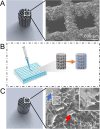3D printing of dual-cell delivery titanium alloy scaffolds for improving osseointegration through enhancing angiogenesis and osteogenesis
- PMID: 34452607
- PMCID: PMC8401189
- DOI: 10.1186/s12891-021-04617-7
3D printing of dual-cell delivery titanium alloy scaffolds for improving osseointegration through enhancing angiogenesis and osteogenesis
Abstract
Background: The repair of large bone defects is a great challenge for orthopedics. Although the development of three-dimensional (3D) printed titanium alloy (Ti6Al4V) implants with optimized the pore structure have effectively promoted the osseointegration. However, due to the biological inertia of Ti6Al4Vsurface and the neglect of angiogenesis, some patients still suffer from postoperative complications such as dislocation or loosening of the prosthesis.
Methods: The purpose of this study was to construct 3D printed porous Ti6Al4V scaffolds filled with bone marrow mesenchymal stem cells (BMSC) and endothelial progenitor cells (EPC) loaded hydrogel and evaluate the efficacy of this composite implants on osteogenesis and angiogenesis, thus promoting osseointegration.
Results: The porosity and pore size of prepared 3D printed porous Ti6Al4V scaffolds were 69.2 ± 0.9 % and 593.4 ± 16.9 μm, respectively, which parameters were beneficial to bone ingrowth and blood vessel formation. The BMSC and EPC filled into the pores of the scaffolds after being encapsulated by hydrogels can maintain high viability. As a cell containing composite implant, BMSC and EPC loaded hydrogel incorporated into 3D printed porous Ti6Al4V scaffolds enhancing osteogenesis and angiogenesis to repair bone defects efficiently. At the transcriptional level, the composite implant up-regulated the expression levels of the osteogenesis-related genes alkaline phosphatase (ALP) and osteocalcin (OCN), and angiogenesis-related genes hypoxia-inducible factor 1 alpha (HIF-1α), and vascular endothelial growth factor (VEGF).
Conclusions: Overall, the strategy of loading porous Ti6Al4V scaffolds to incorporate cells is a promising treatment for improving osseointegration.
Keywords: 3D printed; Angiogenesis; Osseointegration; Osteogenesis; Titanium alloy implant.
© 2021. The Author(s).
Conflict of interest statement
The authors declare no conflict of interest.
Figures





Similar articles
-
In vitroapplication of drug-loaded hydrogel combined with 3D-printed porous scaffolds.Biomed Mater. 2022 Oct 20;17(6). doi: 10.1088/1748-605X/ac9943. Biomed Mater. 2022. PMID: 36220010
-
Incorporating simvastatin/poloxamer 407 hydrogel into 3D-printed porous Ti6Al4V scaffolds for the promotion of angiogenesis, osseointegration and bone ingrowth.Biofabrication. 2016 Oct 27;8(4):045012. doi: 10.1088/1758-5090/8/4/045012. Biofabrication. 2016. PMID: 27788122
-
In vivo study of dual functionalized mussel-derived bioactive peptides promoting 3D-printed porous Ti6Al4V scaffolds for repair of rabbit femoral defects.J Biomater Appl. 2022 Nov;37(5):942-958. doi: 10.1177/08853282221117209. Epub 2022 Jul 20. J Biomater Appl. 2022. PMID: 35856165
-
3D-printed porous Ti6Al4V scaffolds for long bone repair in animal models: a systematic review.J Orthop Surg Res. 2022 Feb 2;17(1):68. doi: 10.1186/s13018-022-02960-6. J Orthop Surg Res. 2022. PMID: 35109907 Free PMC article.
-
A systematic review of preclinical in vivo testing of 3D printed porous Ti6Al4V for orthopedic applications, part I: Animal models and bone ingrowth outcome measures.J Biomed Mater Res B Appl Biomater. 2021 Oct;109(10):1436-1454. doi: 10.1002/jbm.b.34803. Epub 2021 Jan 22. J Biomed Mater Res B Appl Biomater. 2021. PMID: 33484102
Cited by
-
Effect of Ti6Al4V Alloy Surface and Porosity on Bone Osseointegration: In Vivo Pilot Study in Rabbits.Materials (Basel). 2025 May 6;18(9):2141. doi: 10.3390/ma18092141. Materials (Basel). 2025. PMID: 40363646 Free PMC article.
-
Advances in growth factor-containing 3D printed scaffolds in orthopedics.Biomed Eng Online. 2025 Feb 7;24(1):14. doi: 10.1186/s12938-025-01346-z. Biomed Eng Online. 2025. PMID: 39920740 Free PMC article. Review.
-
Low-Intensity Pulsed Ultrasound Promotes Osteogenesis in Porous Titanium Alloys Through miR-1187/BMP4 Pathway.FASEB J. 2025 May 15;39(9):e70583. doi: 10.1096/fj.202403395RR. FASEB J. 2025. PMID: 40317956 Free PMC article.
-
Effect of Pore Size of Porous-Structured Titanium Implants on Tendon Ingrowth.Appl Bionics Biomech. 2022 Apr 25;2022:2801229. doi: 10.1155/2022/2801229. eCollection 2022. Appl Bionics Biomech. 2022. PMID: 35510044 Free PMC article.
-
Reconstruction of massive bone defects after femoral tumor resection using two new-designed 3D-printed intercalary prostheses: a clinical analytic study with the cooperative utilization of multiple technologies.BMC Musculoskelet Disord. 2023 Jan 25;24(1):67. doi: 10.1186/s12891-023-06171-w. BMC Musculoskelet Disord. 2023. PMID: 36698116 Free PMC article.
References
-
- Guo Y, Ren L, Xie K, Wang L, Yu BH, Jiang WB, Zhao YH, Hao YQ. Functionalized TiCu/Ti-Cu-N-Coated 3D-Printed Porous Ti6Al4V Scaffold Promotes Bone Regeneration through BMSC Recruitment. Adv Mater Interfaces. 2020;7(6):13. doi: 10.1002/admi.201901632. - DOI
-
- Zhao Y, Li ZH, Jiang YN, Liu H, Feng YB, Wang ZH, Liu H, Wang JC, Yang B, Lin Q. Bioinspired mineral hydrogels as nanocomposite scaffolds for the promotion of osteogenic marker expression and the induction of bone regeneration in osteoporosis. Acta Biomater. 2020;113:614–626. doi: 10.1016/j.actbio.2020.06.024. - DOI - PubMed
-
- Mansoorianfar M, Khataee A, Riahi Z, Shahin K, Asadnia M, Razmjou A, Hojjati-Najafabadi A, Mei CT, Orooji Y, Li DG. Scalable fabrication of tunable titanium nanotubes via sonoelectrochemical process for biomedical applications. Ultrason Sonochem. 2020;64:11. doi: 10.1016/j.ultsonch.2019.104783. - DOI - PubMed
-
- Li S, Li X, Hou W, Nune KC, Misra RDK, Correa-Rodriguez VL, Guo Z, Hao Y, Yang R, Murr LE. Fabrication of open-cellular (porous) titanium alloy implants: osseointegration, vascularization and preliminary human trials. Sci China Mater. 2018;61(4):525–536. doi: 10.1007/s40843-017-9063-6. - DOI
MeSH terms
Substances
Grants and funding
LinkOut - more resources
Full Text Sources
Research Materials

